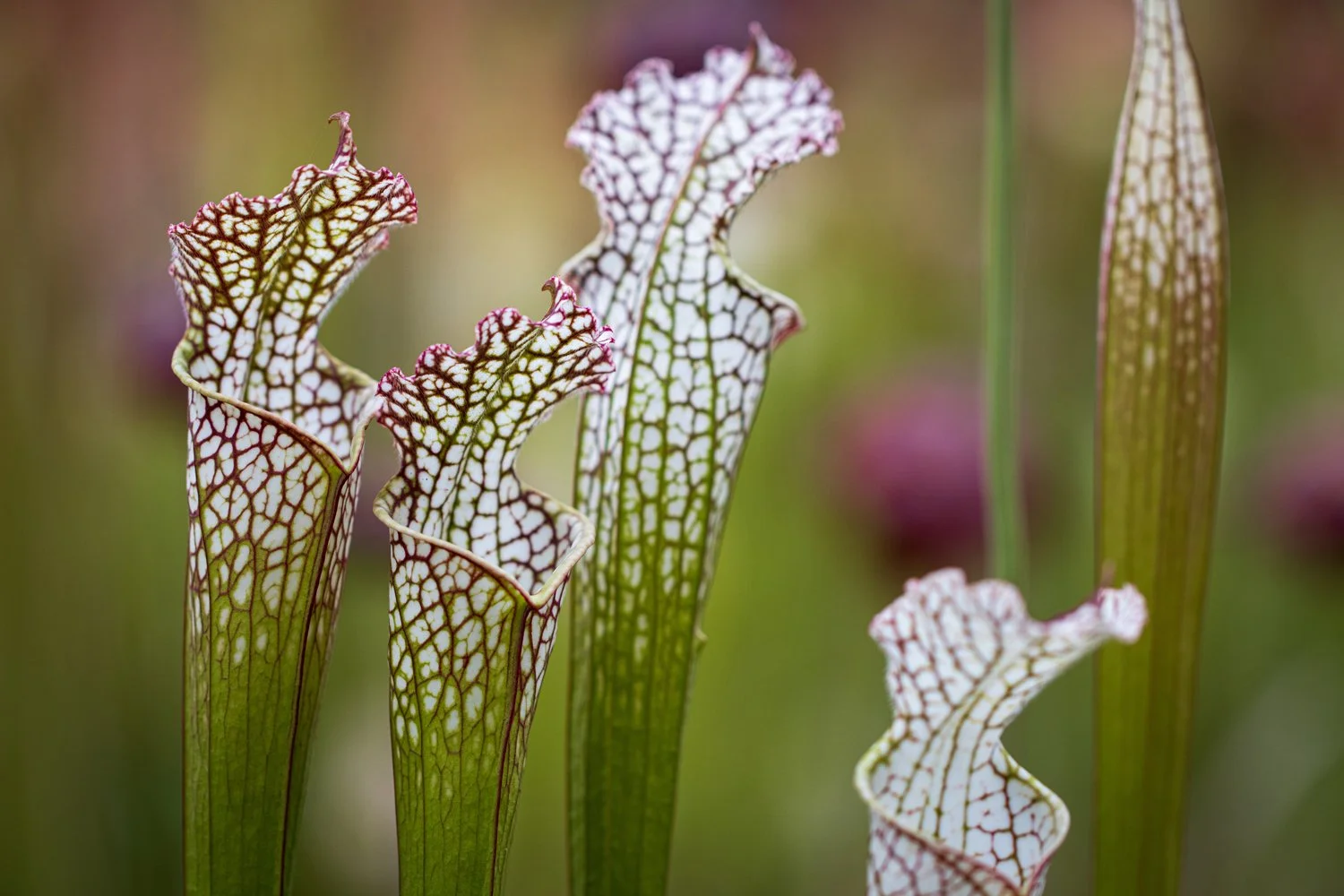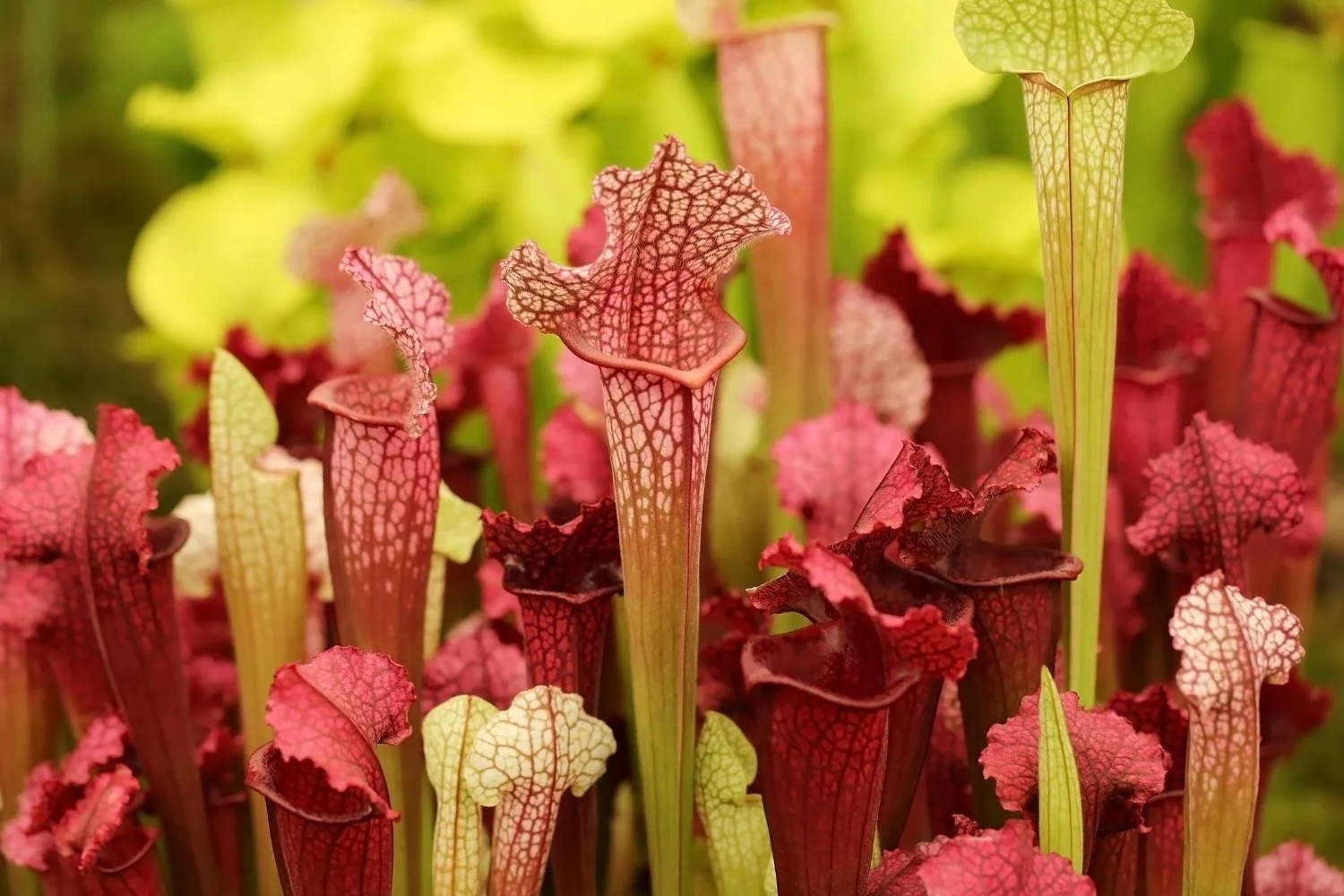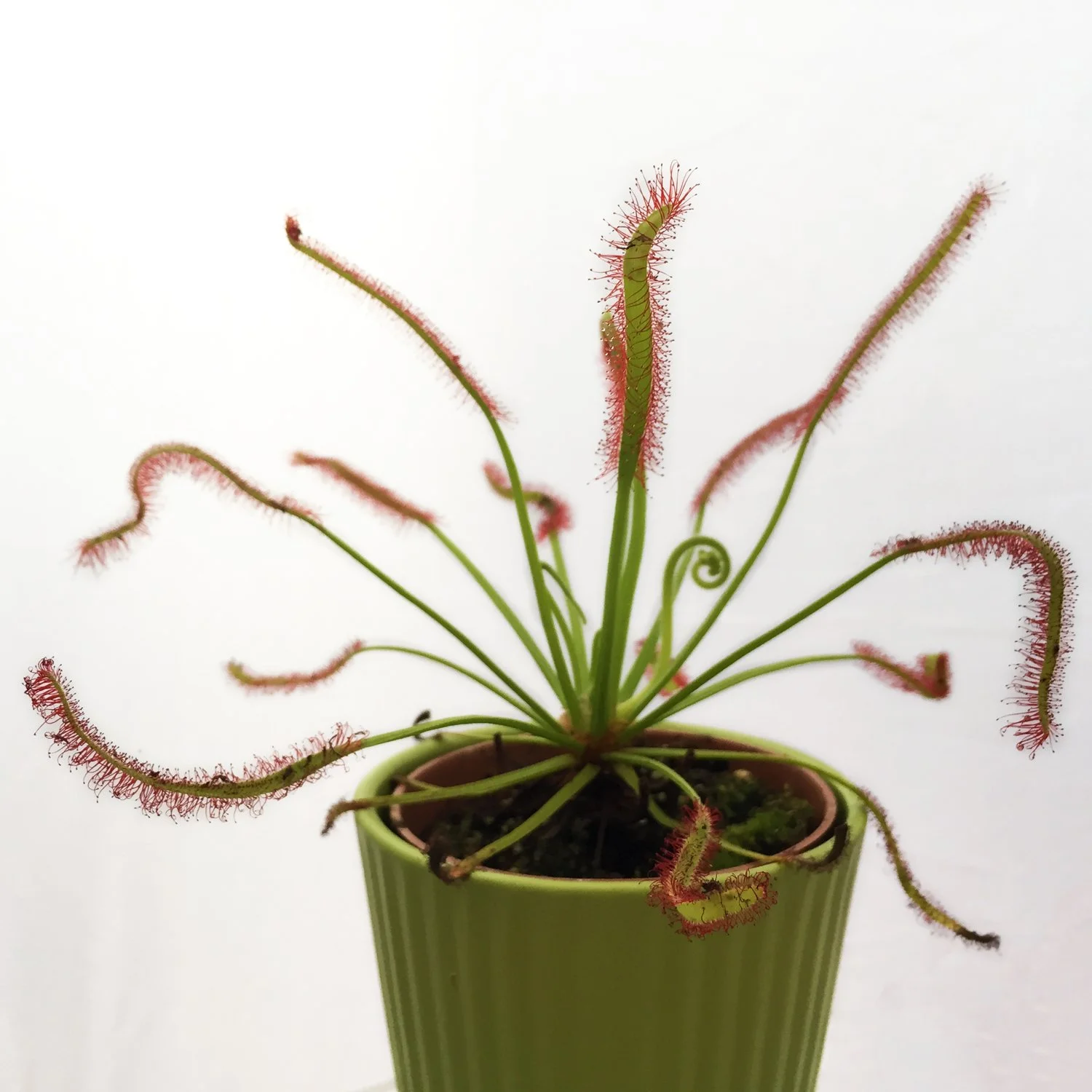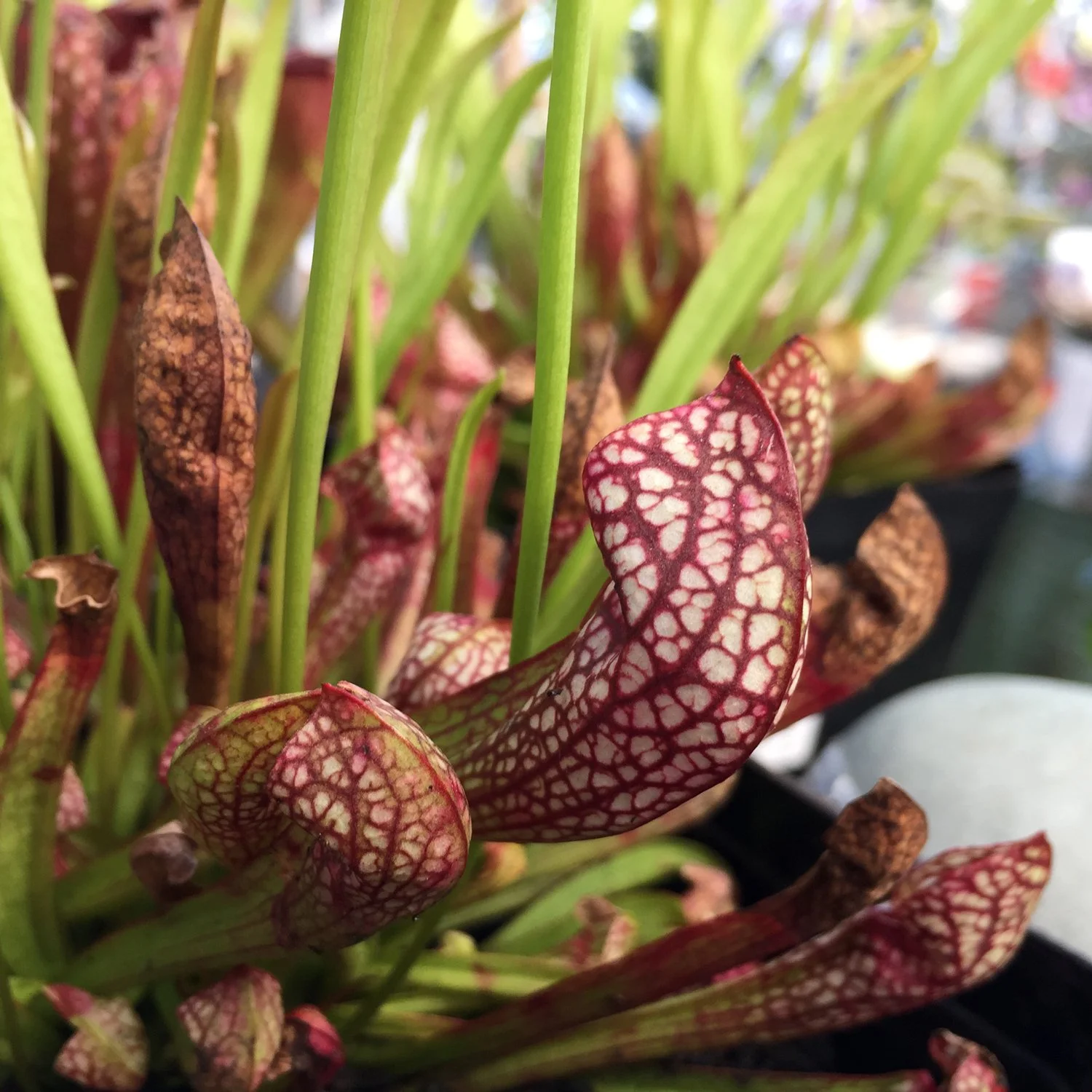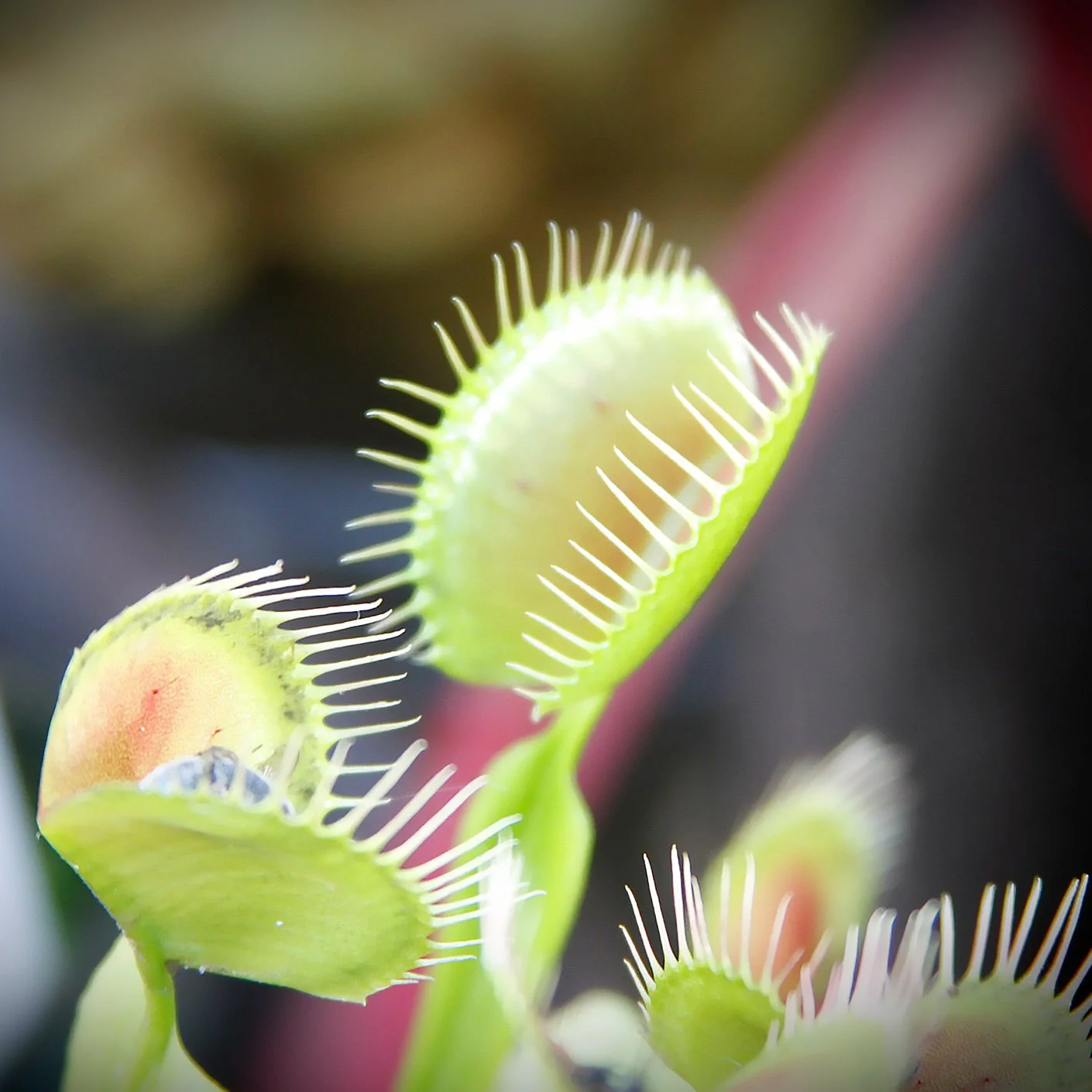All About Carnivorous Plants
No plant captures the imagination quite like a carnivorous one. With oddly shaped leaves that are designed to capture and digest insect prey, carnivorous plants are equal parts unique and sinister. Given the right conditions, sundews, pitcher plants, and flytraps make excellent houseplants. They can be enjoyed for both their beautiful coloration and their carnivorous abilities–the plants naturally attract small insects like fungus gnats and houseflies, keeping your home clear of pests and providing free (if unconventional) entertainment for kids and adults alike.
Why are some plants carnivorous?
Like other plants, carnivorous plants generate all of their energy through photosynthesis. However, carnivorous plants have adapted to acidic, waterlogged, and/or nitrogen-poor soils by obtaining nutrients from animal prey, rather than directly from the soil. While some larger tropical species of carnivorous plants manage to trap and digest small birds or mammals, the majority of carnivorous plants (and those available as houseplants) primarily trap insects and small arthropods. There are several different trap mechanisms, but the main three ways carnivorous plant species capture prey are through sticky “flypaper” traps, passive “pitfall” traps, and rapid-speed “snap” traps. The three houseplants described below are standout examples of each of the three trap mechanisms.
General Guidelines Care for Carnivorous Plants
Most carnivorous plants are adapted to full sun, since the soil types in their native environments cannot support larger, shade-producing trees or shrubs. As such, carnivorous plants need a south- or west-facing windowsill with unobstructed direct sunlight. If these conditions are unavailable in your space, you can replicate them by placing your plant directly under a grow light set to run for 12-14 hours. Besides being critical for photosynthesis, bright light is also important for carnivorous plants with red leaf structures–the plants need copious amounts of light to produce red pigment, and this coloration in turn helps them to attract their insect prey.
Carnivorous plants will not grow well in regular potting mix. While individual species have slightly different soil needs, the carnivorous houseplants described in this article generally prefer a blend of equal parts sphagnum moss and horticultural sand. These materials are available at Swansons, along with small bags of pre-mixed potting medium ideal for carnivorous plants.
Like within their boggy native environments, carnivorous plants are best kept in a quarter-inch of mineral-free standing water at all times, either within a cache pot or a ceramic tray. Swansons carries an excellent selection of double-glazed waterproof Scheurich pottery that is ideal for carnivorous plants; we also have cork mats available to place underneath cache pots or water trays to help protect surfaces from moisture damage. The minerals present in tap water can build up in the potting medium of carnivorous plants and inhibit their growth, so it is best to use distilled water (avoid bottled drinking water) or rainwater. You can also leave tap water sitting out for 24 hours, which allows enough time for minerals like chlorine and fluoride to evaporate out. Finally, it is best to bottom-water carnivorous plants: wetting the plant’s leaves or pitchers can wash away the substances the plants use to trap and digest their prey.
Do not fertilize carnivorous plants–they do not absorb nutrients through their roots like other houseplants, meaning that conventional fertilizers can burn their root systems and inhibit their ability to absorb water. They will obtain all of their nutrients from their insect prey. If kept near an open window or outdoors during the summer, they will catch prey on their own and do not need to feed more than once or twice a month. You can manually feed carnivorous plants live or recently dead insects from around your home, but be careful not to overfeed to avoid leaf rot.
Types of Carnivorous Plants
Sundew / Drosera capensis
The name Drosera describes a large genus of nearly 200 plant species that can be found growing on every continent except Antarctica. The strap-like leaves of Drosera are covered with tiny, hair-like tentacles that secrete a glue-like substance called mucilage that acts as a sticky flypaper. The mucilage is easy to see with the naked eye, resembling small drops of dew coating the plant, hence the plant’s common name, sundew.
The most common type of sundew is Drosera capensis, or the Cape sundew, native to the Cape region of South Africa. This relatively small and easy-to-grow variety makes the Cape sundew an excellent plant for someone interested in trying out carnivorous plants. While the Cape sundew is a relatively tough perennial, it can perish in temperatures below 40 degrees F (5 degrees C), so it needs to be brought indoors during winter in Seattle (if grown outside). Otherwise, the Cape sundew will happily grow indoors year-round in a south- or west-facing window with ample direct sun (or underneath a grow light).
The Cape sundew attracts insect prey with its colorful tentacles and tasty-looking “nectar” (actually sticky mucilage) that glitters tantalizingly in the sunshine. Insects land on the leaves or crawl up the stems, where they become mired in mucilage. As the prey struggles to free itself, the sundew rolls up its leaf, further ensnaring the doomed insect with more sticky tentacles. The insect eventually suffocates, and the tips of the sundew’s tentacles secrete digestive enzymes. Once the plant absorbs all available nutrition from its prey, the leaf will unfurl, leaving behind nothing but a chitinous husk.
The Cape sundew flowers in early summer, producing a tall scape upon which a row of dainty lavender flowers will open one-by-one over the course of several weeks. Each bloom lasts only one day and will then form tiny, grain-like seeds. Cape sundew plants are self-fertile, so seeds will readily germinate alongside the mother plant or even in neighboring pots. The seedlings look like miniature versions of the parent plant.
Like other common carnivorous houseplants, the Cape sundew needs to be kept in a special potting mix for carnivorous plants and left in a quarter-inch of mineral-free water at all times. Do not fertilize the Cape sundew–it will obtain all the nutrition it needs from its insect prey (usually fruit flies, fungus gnats, or houseflies). On occasion, trim dead or dying leaves from your Cape sundew and remove spent insect husks, pet hair, or other plant matter from its leaves to maximize its surface area for new prey.
Pitcher Plant / Sarracenia purpurea and hybrids
Sarracenia describes a genus of about a dozen species of carnivorous plants native to North America. With modified leaves shaped like long funnels, they have earned the common name pitcher plant and deploy the “pitfall” method for capturing prey. Drawn to the red pigmentation and scent of the pitcher lids and rims, unlucky insects then tumble into the mouth of the pitcher and are prevented from escaping the bottom of the pitcher by specialized downward-pointing hairs. Once the insect drowns, digestive enzymes secreted within the pitcher break it down into nutrients that can be absorbed by the plant.
Sarracenia purpurea is the most commonly available houseplant version of the pitcher plant. It is also the only cold-hardy species of Sarracenia, with its native range spanning most of temperate Canada and the northeastern United States. It has naturalized in Washington state and can be found growing as far north as the Alaskan panhandle. In its native range, S. purpurea prefers the waterlogged, acidic soils of bogs. It produces unusual, umbrella-shaped flowers in early spring, which precedes the plant’s formation of new pitchers for the season. There are several hybrid species available featuring different shapes and colorations.
With the right soil conditions, bright sun, and shelter from damaging winds and rain, Sarracenia purpurea can be grown outdoors in the Seattle area. However, you are likely to have better success keeping it as a houseplant. Like other carnivorous houseplants, S. purpurea prefers a bright south- or west-facing windowsill with direct sunlight, mineral-free water, and a potting mixture composed of approximately 60% sphagnum peat moss to 40% horticultural sand. Unlike other common carnivorous houseplants, Sarracenia can be kept in higher amounts of standing water–up to half the length of its pot size. Do not pour water into the pitchers of Sarracenia, as that will disrupt the chemical composition of the enzymatic “soup” that the plant uses to digest its prey and absorb nutrients.
Flytrap / Dionaea muscipula
Arguably the most iconic carnivorous plant, the flytrap (aka Venus flytrap) is the only species within the genus Dionaea, D. muscipula. It has inspired a magnificent array of unforgettable works in popular culture, from the singing, man-eating monstrosity in The Little Shop of Horrors to the deadly piranha plant of the Super Mario Bros. media franchise.
The flytrap is native to bogs and wetlands of coastal North and South Carolina. Like other carnivorous plants, D. muscipula prefers peaty, sandy soils that are low in nitrogen and phosphorus. It produces a tall scape with delicate white flowers in early spring. Natural wildfires in the plants’ wild habitat help to keep D. muscipula from being shaded out by taller grasses and shrubs, and ash acts as a fertile substrate for seeds to germinate in newly-burned areas. While it is common in the houseplant market, D. muscipula is classified as vulnerable to extinction in the wild due to illegal poaching, habitat loss, fire suppression, and sea level rise.
The mechanism for carnivory in D. muscipula is perhaps the most fascinating among carnivorous plants, if not the most dramatic to witness. The modified leaves form a pair of flat lobes ringed with hair-like protrusions, giving the impression of toothy maws. Like its sundew cousins in the genus Drosera, Dionaea leaves deploy red pigmentation and secrete mucilage to help attract insect prey. However, its trapping mechanism goes a step further. Tiny “trigger hairs” on the inside of the leaves send signals to the plant when they are stimulated. An isolated brush will not trip the trap–a piece of windblown debris or minuscule gnat is not worth the effort of closing the trap. If multiple trigger hairs are stimulated in succession–indicating a meal-worthy insect is present in the trap–the leaf will snap shut in the blink of an eye. The toothlike hairs ringing the trap prevent the victim from escaping, and as the prey struggles against the trigger hairs within the trap, the edges of the maw purse together to form a tight seal. As the victim suffocates, the plant pumps digestive enzymes into the trap. Once all available nutrients are absorbed, the trap reopens to reveal a husk of chitin, which usually falls or blows out of the trap to clear it for reuse. While the plants themselves are not fireproof, the trigger hairs of Dionaea are also heat-sensitive, closing in proximity to fire to help the plant avoid excessive damage.
As a houseplant, the flytrap is quite easy to care for since it tolerates lower levels of humidity compared to other carnivorous plants. Give it direct sunlight in an unobstructed south- or west-facing window, using a potting mix composed of approximately 60% horticultural sand and 40% sphagnum moss. Keep a quarter-inch of mineral-free water in its cache pot or tray at all times, and avoid pouring water directly on the traps. While triggering empty traps to close can be fun to watch, this is a waste of energy for the plant and weakens it over time. If you’d like to witness its insect-trapping abilities, use tweezers to place a housefly-sized insect in the trap so the plant gets a meal for its efforts. Gently clear stuck husks from reopened traps to maximize the plant’s ability to catch more insects.
While their care varies slightly from other houseplants, carnivorous plants are relatively easy to grow if given lots of light, proper soil, and mineral-free water. Their unique insect-trapping abilities bring equal parts entertainment and utility to a sunny windowsill, and varieties like S. purpurea give us the rare opportunity to grow a native plant inside our homes. On your next visit to the nursery, allow yourself to be captivated by your favorite carnivorous plant, and give it a try!
Other Resources
Swansons’ Carnivorous Plant Care guide
International Carnivorous Plant Society (facts, care, propagation, conservation, and more)

